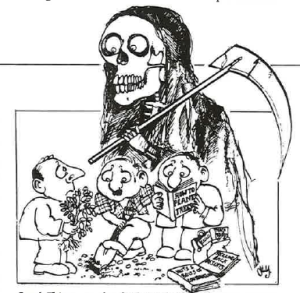“Westchester Environment” – Vol. 2 No. 3 – March 1980  Doom is The Spur By Patrick Allen In the early ‘70s the prevailing orthodoxy amongst conservationists was doom-gloom – the view that very nasty things will very shortly occur unless we very quickly mend our wicked ways. This was the period of A Blueprint for Survival, jeremiads from the Club of Rome – notably (or notoriously) The Limits to Growth – and the Stockholm Conference on the Human Environment. For a time a great many people were mightily exercised by these warnings and even a few of the mighty took time off from (mis)directing affairs of state to Express Considerable Concern. But when the end, so widely heralded as nigh, quite failed to show up, the boom went out of the doom business. Books with titles like The Hungry Future, Standing Room Only, Our Polluted World, Timetable for Disaster, no longer poured from the printing presses, and in the western world earnest young men and women, so lately converted to the edifying values of cycling and recycling, quietly reoccupied their former niches in the gas-guzzling, throw-away society. For all but a hard core of the faithful doom-gloom was out. Yet despite nature’s well-known abhorrence of a vacuum, no revised version of the gospel took its place. Nor has done since. With the result that conservation has joined the long list of Worth Causes of Our Time about which all men of goodwill are agreed that something should be done tomorrow once Pressing Matters have been dealt with today. Doleful finding But of course the main characteristic of Pressing Matters is that they are always with us. Which means that for other matters – conservation for example – tomorrow arrives, if at all, very late in the day. Nowadays even those who should be beating the drum for conservation appear instead to be beating a retreat. A recent polling of environmental journalists produced the rather doleful finding that while most of them accept that the loss of species leads to a world that is aesthetically poorer, most of them do not believe that the loss of species leads to a world that is economically poorer. In other words, while they regard conservation as a Good Thing – in that having animals and plants around jollies up our grey lives – they do not regard it as an Essential Thing. And this from a cross section of environmental journalists! Admittedly many decision-makers (those paragons of our day) are better informed. They readily concede that conservation does matter – in an economic, scientific, in a strictly utilitarian sense. But whereas in former days, when the fear of imminent doom rode high, there was the immediate payoff or popular applause for conservation rhetoric (with the promise of deeds to follow), now there is nothing of the kind. With the result that Pressing Matters (see above) have entirely taken over.
Doom is The Spur By Patrick Allen In the early ‘70s the prevailing orthodoxy amongst conservationists was doom-gloom – the view that very nasty things will very shortly occur unless we very quickly mend our wicked ways. This was the period of A Blueprint for Survival, jeremiads from the Club of Rome – notably (or notoriously) The Limits to Growth – and the Stockholm Conference on the Human Environment. For a time a great many people were mightily exercised by these warnings and even a few of the mighty took time off from (mis)directing affairs of state to Express Considerable Concern. But when the end, so widely heralded as nigh, quite failed to show up, the boom went out of the doom business. Books with titles like The Hungry Future, Standing Room Only, Our Polluted World, Timetable for Disaster, no longer poured from the printing presses, and in the western world earnest young men and women, so lately converted to the edifying values of cycling and recycling, quietly reoccupied their former niches in the gas-guzzling, throw-away society. For all but a hard core of the faithful doom-gloom was out. Yet despite nature’s well-known abhorrence of a vacuum, no revised version of the gospel took its place. Nor has done since. With the result that conservation has joined the long list of Worth Causes of Our Time about which all men of goodwill are agreed that something should be done tomorrow once Pressing Matters have been dealt with today. Doleful finding But of course the main characteristic of Pressing Matters is that they are always with us. Which means that for other matters – conservation for example – tomorrow arrives, if at all, very late in the day. Nowadays even those who should be beating the drum for conservation appear instead to be beating a retreat. A recent polling of environmental journalists produced the rather doleful finding that while most of them accept that the loss of species leads to a world that is aesthetically poorer, most of them do not believe that the loss of species leads to a world that is economically poorer. In other words, while they regard conservation as a Good Thing – in that having animals and plants around jollies up our grey lives – they do not regard it as an Essential Thing. And this from a cross section of environmental journalists! Admittedly many decision-makers (those paragons of our day) are better informed. They readily concede that conservation does matter – in an economic, scientific, in a strictly utilitarian sense. But whereas in former days, when the fear of imminent doom rode high, there was the immediate payoff or popular applause for conservation rhetoric (with the promise of deeds to follow), now there is nothing of the kind. With the result that Pressing Matters (see above) have entirely taken over.
The missing factor, it is clear, is popular pressure – or in the jargon, “public awareness.”… Fearsome predictions where are falsified by events (or rather by non-events) spoil the market for truth.
The missing factor, it is clear, is popular pressure – or, in the jargon, “public awareness.” Of course the apocalyptic warnings of the early ’70s, with their naïve dependence on crude computer models, were counter-productive. Fearsome predictions where are falsified by events (or rather by non-events) spoil the market for truth. And yet… and yet. The environmental pundits of a few years back may have erred in believing that the planet’s life-support systems were heading for imminent and dramatic collapse. But if the truth is that the planet’s life-support systems are softly, invisibly coming apart, is the message very different? If the world ends not with a bang but a whimper, the result is the same. Doom deferred is still doom. Doom deferred, though, is not in itself a rallying cry to action. As who-was-it said: “There is nothing to concentrates a man’s mind as the knowledge that he is to be hanged in a fortnight.” But substitute 15 years for a fortnight and concentration vanishes. How then to recover that focusing public attention on the Conservation Issue? For this, after all, is the truth. The time scale of cause and effect in nature may sometimes be lengthy. But it is nonetheless very real – with the added caveat that the results of what we do or do not do now may prove irreversible. What we do or do not do now also serves to narrow or to expand our range of options. Choice dwindles as resources are used up. Rainforests are shrinking at a frightening speed. World catches of many fish species have plummeted. Deserts are growing at such a rate that one-third of the world’s croplands may have disappeared by the turn of the century. Or take the most obvious example of all: energy. Failure to conserve now makes a full-blown nuclear future – the “technological fix” for a world in a fix – almost inevitable, regardless of hazards. So long as politicians feel that they are more likely to receive kicks than kisses for acting so as to stave off distant and problematic calamity, they will act, if at all, only halfheartedly. But of course people want a healthy future for themselves and even more so for their children. So a public which perceived the real-life choice between Good and Ill – and understands that choosing starts now – will direct both kicks and kisses to Good effect. With a real-live chance of happy outcome. The enemy of action The doom-watchers of the early ‘70s got it wrong. But the doom-watchers of the present day also have got it wrong. They know full well the track we are on but believe a rose-tinted view is all that people should be given for fear of depressing them. This is psychologically inept. It makes for complacency, the enemy of action.
The doom-watchers of the early ’70s got it wrong.
The track we are on is bound for doom but we are not bound to go there. We can backtrack in time. Just in time. And this truth is a truth that should be told. Unavoidable doom breeds only despair but preventable doom is the best of all possible spurs to action. So come back doom, preventable doom – we need you. Originally printed in the bulletin of the International Union for Conservation of Nature and Natural Resources.
